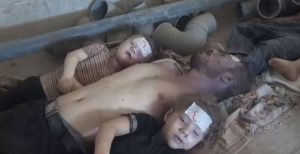Survivors of Gas Attack in Syria Face Long-Term Illness
 A horrified world watched the agonizing deaths of civilian men, women, and children in Syria writhing in pain as first responders frantically hosed off the cruel nerve toxin, sarin, from the bodies of victims suffering and dying while clutched in the arms of their loved ones. Such brutality is intolerable to a civilized world, and the gruesome scene provoked the President of the United States to launch a missile strike, blasting the Syrian airbase where the planes carrying the banned chemical warfare agent had lifted off.
A horrified world watched the agonizing deaths of civilian men, women, and children in Syria writhing in pain as first responders frantically hosed off the cruel nerve toxin, sarin, from the bodies of victims suffering and dying while clutched in the arms of their loved ones. Such brutality is intolerable to a civilized world, and the gruesome scene provoked the President of the United States to launch a missile strike, blasting the Syrian airbase where the planes carrying the banned chemical warfare agent had lifted off.
But what few in the general public realize are the life-long health consequences the survivors of sarin attacks will likely endure. It seems likely that sarin attack victims in Syria will suffer permanent effects. This prognosis is based on decades of research on rats and mice, and the fate of veterans of the 1990-1991 Gulf War who were exposed to low-levels of sarin gas and who continue to suffer serious health effects 26 years later.
Operation Desert Storm has slipped into a historical footnote in the public mind after a ceaseless succession of Middle East wars over the quarter of a century since that 1990 battle, but thousands of service men and women who fought there are still suffering and fighting for their health, stricken by a life-changing disorder called Gulf War Illness.
The precise causes of GWI are still not fully understood, but the leading hypothesis is that exposure to sarin and similar agents likely caused the complicated damaging effects on the body suffered in GWI. “At least 100,000 Operation Desert Storm Gulf War veterans were exposed to low level sarin nerve gas when a weapons depot at Khamisiyah, Iraq, containing rockets with sarin treated warheads was destroyed in March of 1991,” says Dr. Kimberly Sullivan, Assistant Professor of Environmental Health at Boston University School of Public Health. “More recently, it has been documented that a smaller number of veterans from the more recent Operation Iraqi Freedom deployments were also exposed to nerve agents from old chemical munition stocks that were turned into improvised explosive devices,” she says.
Gulf War Illness afflicted as many as 200,000 to 250,000 US veterans of the nearly 700,000 US personnel deployed to the region in the1990-1991 Gulf War, as well as veterans from other countries who served there; an astonishingly high rate of “casualties.” GWI presents a bewildering array of debilitating symptoms, including chronic fatigue, widespread pain, cognitive and memory problems, skin rashes, gastrointestinal and respiratory difficulties, that can persist for decades. The VA now refers to the illness as “Chronic multisymptom illness,” to reflect the plethora of comorbidities victims suffer, and to dispel the early skepticism that surrounded the initial term of “Gulf War Syndrome” and later GWI….
***To continue reading, please see Scientific American: https://blogs.scientificamerican.com/guest-blog/survivors-of-the-gas-attack-in-syria-face-long-term-illness/
Photo credit: https://en.wikipedia.org/wiki/Ghouta_chemical_attack